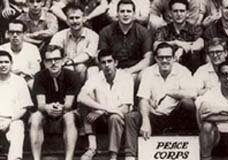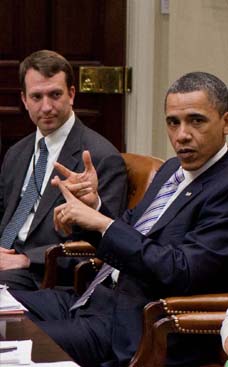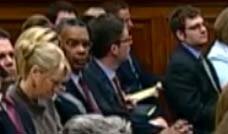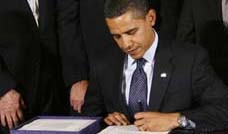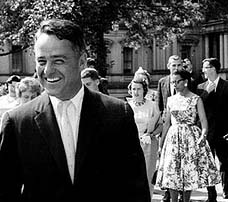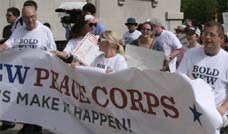
"In conclusion, Volunteers do not want and do not need a marble monument to their service. We do not need a public place that glorifies our service. We receive all the gratitude we need from the villagers with whom we have lived in the Developing World. What we need is to continue our service, quietly, without fanfare, and with a modest sense of our own importance. Arrogance and display dishonors our service. Please, I implore the Subcommittee, do not embarrass us by authorizing this Monument. "
Testimony of Chuck Ludlam In Opposition to H.R. 854 Legislation to Authorize a Peace Corps Monument to the Subcommittee on National Parks, Forests and Public Lands
Testimony of Chuck Ludlam
Returned Peace Corps Volunteer (Nepal and Senegal)
In Opposition to H.R. 854
Legislation to Authorize a Peace Corps Monument
Subcommittee on National Parks, Forests and Public Lands
House Committee on Natural Resources
October 4, 2011
Chairman Bishop and Members of the Subcommittee.
Thank you for inviting me to testify at this hearing on H.R. 854, legislation to authorize construction of a Peace Corps Monument on or near the National Mall.
The last time I testified on the Hill was at the invitation of Senator Chris Dodd, Chairman of the Peace Corps Subcommittee of the Senate Foreign Relations Committee (SFRC). He invited me and my wife Paula to represent the 8,000 Volunteers at his hearing on the Peace Corps Volunteer Empowerment Act. We flew into Washington from Senegal, where we were serving as Volunteers.
I am accompanied to this hearing by Paula, who has also served twice as a Peace Corps Volunteer. Both times we served, we loved being Volunteers, but when we served the second time from 2005-2007, we were shocked and appalled at the decline in the professionalism of the Peace Corps over the previous 35 years since we'd previously served. This launched our campaign to reform the agency, starting with our testimony before the SFRC.
In the five minutes allotted to me, let me make eight points opposing the ill-conceived proposal to authorize a Peace Corps Monument.
1. 20/20 Expose of Scandals at Peace Corps: The Definitive Argument Against Monument
More important than listening to what I have to say would be for you to view the 20/20 broadcast regarding its investigation uncovering epic and existential scandals in the Peace Corps. http://abcnews.go.com/blotter/peace_corps After viewing these broadcasts, I believe you will conclude that the sponsors of this legislation should withdraw it from consideration.
The Subcommittee should let this scandal unfold and not permit the Peace Corps and its supporters use this Monument to "change the subject" and gloss over this ongoing and unresolved scandal. In time, we may have the verdict of history regarding the dimensions and meaning of this Peace Corps scandal. Letting history judge is precisely why the Commemorative Works Act sets a 25-year time period.
2. Mall Monuments to Ideas: A Problematic Precedent
Even if the Peace Corps were worthy of a monument on the Mall, which the 20/20 expose and our testimony establishes that it is not, the legislation is said to authorize construction of a "commemorative…to mark the historic and enduring significance of the establishment of the Peace Corps in 1961 and the ideals of world peace and friendship its founding represents." The reason why the legislation is stated in this way is that the Commemorative Works Act (P.L. 107-217; Chapter 89) "limits monuments to memory of an individual, group, event or other significant element of American history that have been dead or past 25 years." This means that a Mall Monument to the Peace Corps itself or to the Volunteers could not be authorized.
The framing of this legislation is intended to evade the limitations of the Commemorative Works Act. Indeed, the legislation would set an unfortunate precedent that would lead to other monuments that do not withstand the test of history.
To say that the Peace Corps' founding is "past" 25 years is a patent evasion of the time limit. It's like arguing that we count the years from President Reagan's birth in 1911 rather than from his death in 2004 in determining when a monument to him might be authorized. The Subcommittee could authorize a monument to him in 2029 and it could authorize a monument to the Peace Corps 25 years after it no longer exists.
The fact that the Peace Corps is now facing this epic and existential scandal shows why the Commemorative Works Act demands the 25 year interval. Only AFTER this interval will the verdict of history become clear. The verdict of history with regard to the Peace Corps is now very much in doubt and worse challenges to its reputation may well arise to embarrass any Member who supports this authorization.
In its testimony last year before this Subcommittee, the National Park Service testified that it had "concerns that th[e Peace Corps Monument] could set an unwelcome precedent for any and all future concepts identified only as ‘ideals,' resulting in an untenable influx of memorial proposals." We agree.
Roger Lewis, testifying at last year's hearing in favor of the Peace Corps Monument, said that the Peace Corps ideas are "humanitarian service motivated by compassion; belief in the right of all to pursue life, liberty and opportunity; commitment to help eliminate barriers of poverty, ignorance and disease; and an unwavering optimism about building a better world for all humankind." This definition provides nothing in the way of a definition of anything that is unique about the Peace Corps.
Surely the Peace Corps "ideal" is less significant than many other quintessentially American ideals, including that of representative democracy, free enterprise economics, free trade, First Amendment freedoms, the Bill of Rights, separation of church and state, the Declaration of Independence, the United States Constitution, the rule of law, the nonprofit sector, the federal system, tolerance towards immigrants, the national parks, and environmental ideals. None of these noteworthy ideals is commemorated with monuments on or near the National Mall, not should they be.
As a Monument to the ideal of people-to-people exchange programs, the Peace Corps might be compared to the Fulbright program, or the American Field Service (AFS) program, both of which are older and larger and neither of which have Mall monuments.
As a Monument to the ideal of humanitarian assistance and amelioration of poverty, the Peace Corps pales in comparison to the Marshall Plan.
Interestingly, there already exists a "Peace Monument" on the Mall. It was erected in 1877-1878 to commemorate the naval deaths at sea during the Civil War. The 44-foot-high monument stands in the circle to the west of the Capitol at Pennsylvania Avenue and First Street, N.W.
Indeed, there are many dozens of monuments to "peace" in Washington, D.C. For a comprehensive list see http://peace.maripo.com/x_us_dc.htm Dozens more "peace" monuments have been proposed. See http://peace.maripo.com/y_future.htm
As the Subcommittee is aware in 1987 the Congress authorized a National Peace Garden to be located at Hanes Point along the Potomac River. It was proposed by Peace Corps alumni because they understood that the Commemorative Works Act would not permit them to propose a monument to the Peace Corps or Peace Corps Volunteers. Even though the authorization was twice extended, the project collapsed and the authority lapsed. What we have now is simply another artfully crafted Peace Corps proposal to evade the commandments of the Commemorative Works Act.
The monument to Japanese-American patriotism during World War II is a monument to an historical event that is 25 years past, not to an ideal. It focuses on the heroism of Japanese-Americans and the internment camps, both historic events where we have the clear and unequivocal verdict of history.
If this Monument is, in effect, a monument to President John F. Kennedy, we already have a monument to him in the Kennedy Center for the Performing Arts and do not need a second one.
We submit that the Congress should not report or adopt legislation that authorizes ANY monument to ANY ideal. To do so sets up a slippery slope where monuments to ideals could be proposed that would clutter the Mall. If it does, then the Peace Corps should not stand in the front of the line.
3. Mall Monuments to Government Agency: A Problematic Precedent
In reality, this proposed Monument would effectively memorialize a current government spending program at a time when government spending is seen as excessive and destructive. The timing for a monument to a government spending program couldn't be worse or more politically embarrassing.
If the Subcommittee takes this legislation to the floor, it risks the likelihood that a fiscally responsible Member concerned about the deficits and debt would say that now is not the time to authorize a monument to ANY government spending program.
This proposed Monument would also effectively memorialize a current government agency that comes to the Congress for authorizations and appropriations. The Monument would constitute a permanent and dramatic Congressional good-housekeeping seal of approval on the Peace Corps - undermining future oversight of the agency to hold it accountable. This proposal says, in effect, that the Peace Corps - as compared to all other government agencies and programs (past or present) - deserves special recognition on the hallowed National Mall and special support in the Congress. The Monument implies that the Peace Corps should be immune from oversight, accountability and reform because it is beyond reproach. This is nonsense and counter-productive. This permanent endorsement of the Peace Corps would persist even if the agency continues to be rife with scandals or is abolished or becomes obsolete. The monument should be seen by supporters of the agency as an attempt to make the Peace Corps a permanent Federal agency irrespective of its performance, cost, mismanagement, or relevance.
This is why it would not be wise for the Congress to set the precedent of authorizing a monument to ANY of the hundreds of current government agencies.
Picking out the Peace Corps from among all of the Federal agencies is not warranted. Sadly, the Peace Corps is a government agency that believes that the solutions to the world's problem come from government spending in support of, and bureaucratic management of, voluntary service. This is top-heavy, bureaucratic 1960s vision. The 21st Century vision is to rely on the private sector, free enterprise economics, and markets to solve the world's problems.
The Peace Corps bureaucracy is bloated with as many staff today as it once had to manage twice as many Volunteers. It's a bureaucracy that is crippled by 33 political appointees, the highest per capital number of appointees in the government. For a long time, it has been a dumping ground for the politically well-connected.
The future of the Peace Corps is in doubt because it costs approximately $50,000 per year to field a Peace Corps Volunteer. The Congress has already authorized a program to compete with the Peace Corps - Volunteers for Prosperity (VfP), a decentralized private sector approach to international service originating with President George W. Bush and authorized in the Kennedy Serve America Act. It costs 1/10th or 1/20thas much to field a VfP volunteer. The Peace Corps is wall-to-wall government, like VISTA, a program that is now dwarfed by AmeriCorps - a cost-effective, decentralized approach where volunteers are placed with nonprofits. The Monument assumes that the Peace Corps will survive this new competition.
4. Monument to Agency Whose Staff Murdered Volunteer Whistle Blower: Inappropriate
Even if the Subcommittee concludes that it is appropriate to authorize a mall to an ideal and a monument to a current government agency, it should not authorize a monument to the Peace Corps due to the current scandals.
The 20/20 expose focused in part on the case of a Peace Corps Volunteer whistle blower who was murdered by Peace Corps staff whom she had reported was raping students at her school.
To reiterate, this case involves a Peace Corps staffer murdering a Peace Corps Volunteer because she was a whistle blower. This case presents an existential challenge to the prevailing mystique about the Peace Corps because it arises from the culture and polices of the Peace Corps, not just from the rage of one individual against a Whistle Blower.
This Whistle Blower, Kate Puzey, begged that her identity be held in confidence. This was in March of 2009 in Benin at a time when the Peace Corps had no rules to protect Whistle Blowers and had vociferously objected to legislation that would have given Volunteer Whistle Blowers protection. So, it is not surprising that the Peace Corps blew Kate's cover to the accused Peace Corps staffer and failed to warn her that she was in immediate and dire jeopardy. As a foreseeable consequence, the accused Peace Corps staffer retaliated by slitting Kate's throat.
Since then, the Peace Corps has made efforts to cover up this crime and obscure the culpability of Peace Corps headquarters in the murder.
The Peace Corps failed to immediately investigate the crime scene. When it finally sent investigators to Benin two months later, it sent auditors. Some years earlier the current Peace Corps Inspector General had acquiesced in stripping her office of responsibility and staff for investigating crimes against Volunteers. This action was intended to minimize the prolonged adverse publicity that tends to accrue to the agency when it acts vigorously to prosecute those who perpetrate these crimes. So, when Kate was murdered, the Peace Corps IG no longer had the ability to respond effectively. It appears that because the investigation of the crime was bungled that the Government of Benin will set the murderers free for lack of evidence.
In addition, the Peace Corps failed to refer the case to the Federal Bureau of Investigation to determine whether the Country Director should be indicted for violating Kate's civil rights.
Even worse, two years beforeher murder in 2007, Senators Chris Dodd and Ted Kennedy had introduced legislation mandating that the Peace Corps guarantee confidentiality for Volunteer whistle blowers and protection against retaliation. In July 2007 while serving as Volunteers in West Africa, Paula Hirschoff and I flew to Washington to testify before the Senate Foreign Relations Committee in favor of the Dodd/Kennedy Whistle Blower protections. The Peace Corps opposed that legislation. It disparaged the idea that there was anything wrong in the Peace Corps. The National Peace Corps Association (NPCA), the principal supporter of this Monument, also opposed the legislation and effectively worked to kill it. Then in March 2009 Kate was murdered precisely because Peace Corps Volunteer Whistle Blowers had no protections.
In this case, the actions and policies of Peace Corps Headquarters make it just as culpable as the actions and policies in Benin. The reluctance of the Peace Corps to listen to and respect Volunteer Whistle Blowers such as Kate - and its refusal to grant them confidentiality and protections against retaliation - is deeply entrenched in Peace Corps culture. This means that this murder cannot be dismissed as an isolated or unforeseeable event.
In March 2010, a year afterKate was murdered, Paula and I tried again to enact protections for Volunteer Whistle Blowers, raising them as amendments to the 2009 Dodd Peace Corps Reauthorization legislation. Again, the agency and NPCA opposed and killed them.
In June 2010 after Senator Dodd had formally requested that the Peace Corps "assess" mechanisms to solicit Volunteers' views on a confidential basis, the Peace Corps refused to do so. It wouldn't even "assess" these issues, let alone act to protect Volunteer Whistle Blowers. This confirms the Peace Corps' deep seated hostility to Volunteer Whistle Blowers.
On January 14, 2011, the same daythat the 20/20 expose of the Puzey case was broadcast, the Peace Corps promulgated its first rules (amendments to the Peace Corps Manual) to protect Volunteer Whistle Blowers. The new rules are narrow, confusing, and cumbersome. We have enumerated 23 major problems with these rules.
The bottom line is that the Peace Corps published poorly crafted rules 33 years after all other Federal employees came under the Federal Whistle Blower Act of 1978. This is an unconscionable delay, one that proved to be fatal to Kate Puzey.
Sadly, the new Peace Corps whistle blowers rules - which have the Volunteers report to the Peace Corps Inspector General rather than to the Merit Systems Protection Board - are not being effectively implemented. This is no surprise given the decision of the current Peace Corps IG to acquiesce in the stripping of her office of investigative authority for crimes. We are aware of a case just a month ago where a Volunteer blew the whistle on Peace Corps staff for jeopardizing her health and she was not protected. Her service was terminated. So, it's clear that the new rules are having little or no impact in protecting Volunteer Whistle Blowers.
The Puzey case demonstrates that the Peace Corps lacks the values that a monument on the Mall should commemorate. To authorize this Monument is to ignore this scandal and imply that it does not exist.
5. Monument to Agency that Mistreats Volunteers Who Are Victims of Rape and Sexual Assault: Inappropriate
The same 20/20 expose that highlighted the Puzey case also highlighted the despicable ways in which the Peace Corps has managed cases where Volunteers have been raped or sexually assaulted. The subcommittee needs to read the testimony that courageous Volunteers who have been victims of such crimes presented before the House Foreign Affairs Committee about their subsequent mistreatment by the Peace Corps. The subcommittee will surely conclude that the Peace Corps Monument is ill-advised.
The Peace Corps has failed to develop sensitive, professional policies and practices to prevent rapes and sexual assaults and to follow current best practices in caring for the victims.
This delay is also unconscionable.
Incidents of rape and sexual assault in the general population are substantially underreported because women fear that they will be blamed or demeaned. Peace Corps victims are especially reluctant to report these crimes because they have seen that the staff blames and demeans victims and tries to sever connections with them as soon as possible. The insensitivity of the Peace Corps to these victims is especially shocking because it arises from the pervasive failure of the Peace Corps to listen to and respect Volunteers, the core issue that led to Kate Puzey being murdered.
Again, these cases demonstrate that the Peace Corps lacks the values that a monument on the Mall should commemorate. To authorize this Monument is to ignore this scandal and imply that it does not exist.
6. Monument to Poorly Managed Government Agency: A Problematic Precedent
Going beyond the Puzey and rape/assault case scandals, the Peace Corps is among the worst managed agencies of the Federal government.
The Congress is aware of these short comings. It has recently substantially cut the Peace Corps appropriations. Over the decades, Peace Corps appropriations have been cut repeatedly in real terms. The Peace Corps fields fewer than half as many Volunteers as it once did. This is hardly an endorsement of the agency by the Congress.
The Volunteers in the field overwhelmingly (46% to 20%) support reforming the Peace Corps over expanding it. Yet, the Peace Corps bureaucrats push only for expansion, not improvement in quality.
The Peace Corps has been giving false information to OMB and the Congress - and the applicants - the scandalously high early quit rates of the Volunteers. The actual early-quit rate has exceeded 40% in 35 countries, contradicting the Peace Corps' claims about rates being one forth as high. See country-by-country list in Appendix. The Volunteers are talking with their feet and the applicants need to know this so they can make an informed decision about accepting an invitation to serve in one of these troubled programs. The cost of these early quits is enormous, perhaps one-third of the agency's budget. And it's demoralizing to the Volunteers who don't quit early and to the communities that relied on their service.
The Peace Corps is violating FOIA to hide its own surveys of the Volunteers because they report that perhaps only 15 of the 75 country programs are well managed. The applicants need to see these surveys country-by-country so they can make an informed decision about accepting an invitation to serve in one of the least well ranked programs. Paula Hirschoff and I have been forced to file a Federal law suit to gain release of these surveys under FOIA and we have just heard that the Justice Department and the Peace Corps will settle the suit and produce the documents. President Obama has issued an Executive Order that his Administration will be transparent. Apparently the Peace Corps does not feel bound by that order because it has so much to hide.
Volunteers have supported shuttering at least 10 of the worst managed country programs. The Peace Corps does not listen to them.
During the Peace Corps' recent and unsuccessful campaign to double the number of Volunteers, it pursued a vigorous strategy to suppress any and all proposals for reform that might imply that the Peace Corps is not perfect. The premise of the doubling campaign was dubious given the fact that there has been no surplus of applicants that survive the medical screening process.
The Peace Corps does not and cannot document a significant record of effectiveness as an agent of grassroots development. The Peace Corps is not internationally known for any development concept or initiative that it has taken to scale. On an individual basis, many Volunteers achieve sustainable development results, but they would typically say that they did so in spite of the Peace Corps bureaucracy.
The reason why the Peace Corps is so ineffective is clear. Regarding its First Goal of sustainable grassroots development, for over 50 years, the Peace Corps has had no effective system to document the Volunteer projects that worked and those that did not. It has minimal systems to document Volunteers' work on a site-by-site basis or to develop strategic plans for each site. When the Volunteers develop an effective project, the Peace Corps has no system for taking those plans to scale. The Peace Corps makes essentially no use of Best Practice Guides. It could have developed thousands by now based on the experiences of 200,000 returned Volunteers. That it failed to do so is an irretrievable waste and loss. In addition, the Peace Corps has not updated its philosophy or strategy for development and does not participate in international debates about the most effective ways to spur development.
In addition, the Peace Corps does not provide seed capital for Volunteer projects. Yet such seed capital is sorely needed to launch demonstrations. Host country nationals are not persuaded by ideas and talk; they learn when they can see something demonstrated. The lack of seed capital is crippling and demoralizing to the Volunteers. And the Peace Corps has set up bureaucratic rules that keep Volunteers from fundraising to support their projects. The Dodd/Kennedy Peace Corps reform bill (2007) would have allocated seed capital to Volunteers and permitted more Volunteer fundraising but the Peace Corps and NPCA opposed both.
As a result of these First Goal failures, new Volunteers usually start from scratch with little guidance on projects and strategies that they might seek to implement. Predictably, many young Volunteers get frustrated and quit - literally or figuratively. The Peace Corps' failures as a grassroots development agency not only hurt the Volunteers; they also deprive the host countries of the kind of assistance they desperately need and deserve.
The five-year limit on the tenure of Peace Corps staff means that no one stays very long, so the agency has little institutional memory. Short-term civil service staff cannot stand up to the political appointees. Staff turnover is constant and chaotic. Because of the five-year rule, agency staff do not have civil service rights. They are considered "temporary" employees who lack key rights of other federal employees. They can be fired arbitrarily at the whim of a political appointee. Staff Whistle Blowers have no protections and we are aware of Peace Corps staff who have blown the whistle who have recently been fired.
You may ask why the need for Peace Corps reform is not better known. Throughout its history, the Peace Corps has been tenacious in suppressing bad publicity. It considers itself to be divinely inspired as the principal legacy of Camelot. It conceals information about the many Volunteers who quit early and the serious problems revealed in its Volunteer survey results. During the doubling campaign the Peace Corps and NPCA quashed pending reform legislation and discussion of reforms. They could not justify expansion if they acknowledged the need for reform. Moreover, the Volunteers have little incentive to speak up for change. Instead, many quit early in frustration, often blaming themselves for the problems they experienced. When younger Volunteers return home, they are soon too preoccupied with readjusting to get involved with reform. Few Volunteers know how to organize to seek reform, and the Peace Corps gives them no effective outlets in policy-making circles. In this information vacuum, the media usually produce puff pieces when they cover Peace Corps. There is no effective oversight from the Congress and NPCA defends management to preserve its financial ties to the Peace Corps. With no one holding the agency accountable, it is no surprise that the Peace Corps has atrophied. It's being destroyed by sycophants.
The Volunteers who do speak out about mismanagement are often shunned or sent home.
In most countries Volunteers say that to survive the bureaucracy they must "fly under the radar" and stay clear of management. When Volunteers succeed, they often say that it's in spite of, not because of the bureaucracy. The root cause of this labor-management divide is that the Peace Corps lacks sufficient respect for the Volunteers to establish effective listening mechanisms.
It is true that the Peace Corps experience is often transformative for the Volunteers themselves, but this is hardly an argument for glorifying this benefit with a Monument.
7. A Self-Congratulatory Monument: An Embarrassment
Many former and current Volunteers are embarrassed by the idea that our service deserves a Monument on the Mall. The hallmarks of the Peace Corps Volunteers are modesty and humility. But this Monument is about self congratulation and ego.
8. Peace Corps Monument: Indefensible Priority for National Peace Corps Association
NPCA's original estimate was that it needed to raise $7 million to construct and endow the Monument. With its marginal record of fund raising to support the recent 50th anniversary celebration - its original plan called for it to raise $21 million for the Monument and Third Goal grants - it appears that NPCA does not have the capacity to raise the funds needed to construct this Monument. To raise $7 million, it would probably need to expend $1 million and substantial additional sums to hire consultants to navigate the tortuous 24-step approval process.
More important, if it could raise such a huge sum, the NPCA could make much better use of it. The monument that we Returned Volunteers need is funding for development programs here in America, fulfilling the Peace Corps' Third Goal. NPCA, the Congress and the Peace Corps have never provided this funding. Sadly, NPCA killed the 2007 Dodd Peace Corps Volunteer Empowerment Act that would have enacted fundamental reforms and would have authorized Federal funding to make these grants. $7 million could fund a permanent endowment for 35 $10,000 grants per year for returned Volunteers for these projects. This would be a living monument consistent with the values of the Peace Corps.
I am aware of these cost estimates because I served as an elected member of the board of NPCA. When it became clear that NPCA would continue to press for the Monument, oppose fundamental reform to empower Volunteers, side with management against the Volunteers to protect NPCA's financial support from the Peace Corps, refuse to oversee Peace Corps' misconduct and mismanagement, and champion doubling at the expense of quality, I resigned from the Board.
Conclusion
In conclusion, Volunteers do not want and do not need a marble monument to their service. We do not need a public place that glorifies our service. We receive all the gratitude we need from the villagers with whom we have lived in the Developing World. What we need is to continue our service, quietly, without fanfare, and with a modest sense of our own importance. Arrogance and display dishonors our service. Please, I implore the Subcommittee, do not embarrass us by authorizing this Monument.
Thank you for the opportunity to present this testimony. I am happy to answer your questions.
Appendix: Peace Corps Early Quit Rates (Obtained from Peace Corps Via FOIA)
The 35 Peace Corps country programs with early-quit rates of more than 40% include: Armenia 42.2% (05); Belize 42.5% (06); Botswana 47.5% (06); Burkina Faso 45.5% (05), 40.3% (06), and 41.4% (07); Cameroon 55.6% (05); Cape Verde 44% (05); Eastern Caribbean 44.4% (06) and 42.3% (07); Ecuador 44% (06); Ethiopia 47.4% (08); Fiji 53.1% (06); Georgia 48.9% (05); Guyana 50% (06) and 42.4% (07); Jamaica 45% (05), 44.1% (07), and 48% (08); Jordan 50% (05), 59.5% (07), and 55.3% (08); Kazakhstan 52.5% (05) and 46.6% (08); Kenya 41.2% (05); Kiribati 55.2% (05), 53.5% (06), and 86.7% (07); Kyrgyzstan 56.1% (05), 52.5% (06), 51.6% (07), and 56.7% (08); Mexico 46.7% (05); Micronesia 42.3% (06) and 44% (08); Moldova 46.2% (05), 42.5% (07), and 42.6% (08); Mongolia 41.7% (07) and 43.9% (08); Morocco 48.5% (05); Niger 41.4% (06); Samoa 50% (05) and 56.3% (07); South Africa 56.5% (07); Surname 73.7% (05), 61.5% (07), and 40% (08); Swaziland 51.5% (05) and 40.7% (06); Togo 53.5% (07) and 41.7% (08); Tonga 53.5% (06) and 45.5% (08); Turkmenistan 40.5% (05) and 48.5% (06); Uganda 44.1% (05); Uzbekistan 43.8% (05); Vanuatu 43.1% (05); and Zambia 47% (08). Fifteen of these countries have had early-quit rates greater than 40% in multiple years.
Charles (Chuck) Ludlam
4020 Reno Road NW, Washington, D.C. 20008
Chuck.Ludlam@gmail.com
Peace Corps Volunteer, Nepal 1968-1970
Shri Mahaveer Janta Secondary School, Haripur, Sarlahi District, Janakpur Zone, Nepal: Funded construction of science building in village where served as Peace Corps Volunteer (1999-2000).
Peace Corps Volunteer, Senegal, 2005-2007 (with Paula Hirschoff)
Chuck and Paula were invited to represent 8,000 Volunteers at hearing of the Senate Foreign Relations Committee, July 25, 2007 in support of Peace Corps Volunteer Empowerment Act (S. 732). In order to do so, they traveled to Washington, DC from Senegal at their own expense, even though the Defendant Peace Corps initially threatened to terminate their service if they testified. Their testimony highlighted the need for the Peace Corps to protect Volunteer whistle blowers.
Ludlam v. U.S. Peace Corps, Case No. 1:11-cv-01570 (EGS) (D.D.C.) - lawsuit under FOIA (refusal of the Peace Corps to disclose the results of its surveys of the Volunteers regarding the agency's performance).
Peace Corps Connections: Chuck Ludlam is married to Paula Hirschoff. From 1968 through 1970, Chuck served in Nepal and Paula served in Kenya. More recently, they served together in Senegal from 2005 through 2007. In each case, they honorably completed their term of service. In 1986, Chuck was co-founder of Friends of Nepal, an association of Returned Volunteers who served in Nepal. He is a former elected member of the Board of Directors (2008-2009) of the National Peace Corps Association, which is a nonprofit organization that supports Returned Peace Corps Volunteers and the Peace Corps community through networking and mentoring to help guide former Volunteers through their continued service back home. He was ejected from the NPCA Board due to his opposition to the Peace Corps Mall monument. In 2008, Chuck served as an Advisor to the Obama/Biden Transition Team for the Peace Corps. Paula has served on the Board of Friends of Kenya, an association of Returned Volunteers who served in Kenya. Chuck and Paula met in 1988 at a Peace Corps commemoration for the 25th anniversary of the death of President John Kennedy and were married in 1992.








